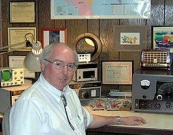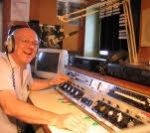Broadcast Station Hourly Identifications – When and How?

[March 2013] This is an updated part of a series of articles taking a look at various FCC Rules and how they can be understood and applied.
According to the FCC, broadcast stations (and nearly all other kinds of licensed stations as well) are supposed to provide clear, easily understood station identification announcements. This was the back-ground of the famous line, initiated and used as a “heads up” from the radio networks to local affiliates: “We now pause for station identification …”
According to the Rules
While the time requirements vary from radio service to radio service, for broadcast stations, FCC Rule 73.1201 asks for station identifications to be made “(1) At the beginning and ending of each time of operation, and (2) Hourly, as close to the hour as feasible, at a natural break in program offerings.
73.1201 then goes on to provide some “fine points” as to exactly what constitutes a “legal ID.”
The most pertinent part for our discussion is section 73.1201(b): Content. (1) Official station identification shall consist of the station’s call letters immediately followed by the community or communities specified in its license as the station’s location; Provided, That the name of the licensee, the station’s frequency, the station’s channel number, as stated on the station’s license, and/or the station’s network affiliation may be inserted between the call letters and station location.
At the end of the section (b)(1), the Rule addresses digital (HD) operations by stating: A radio station operating in DAB hybrid mode or extended hybrid mode shall identify its digital signal, including any free multicast audio programming streams, in a manner that appropriately alerts its audience to the fact that it is listening to a digital audio broadcast. No other insertion between the station’s call letters and the community or communities specified in its license is permissible. With that in mind, let us take a moment to discuss what the FCC says, what it means, and how to comply.
The Call Letters
To begin, the station identification is based on the license – the one required to be post at the station’s control point.
The call letters themselves can be simply four letters – KXXX, for example – or it may require a suffix, exactly as shown on your station license: KXXX, KXXX, KXXX-FM, KXXXLP, or KXXX-DT for example. In the case of digital radio operations, the (b)(1) para-graph above would indicate KXXX-HD or KXXXHD2 is the proper method of identifica-tion.
As an example, an AM/FM combo usually is identified as KXXX and KXXX-FM. A standalone analog FM normally would be expected to be KXXX.
But be careful. Note should be made of stations that at one time were simulcasting and then changed the call letters on one station, but not the other. Consider the case of KXXX AM and FM when the AM changes format and becomes KYYY. The FM would normally switch to KXXX – unless the FM’s license was not adjusted officially when the AM was changed. In that case, it would still be KXXX-FM, even though no KXXX AM existed.
Some Examples
First of all, we want to look at the content of the station identification. For example, consider a station that is licensed (as shown on the station license) to Lakewood, Colorado. By the way, the studio location is not interchangeable with the city of license.
Correct: “KXXX, Lakewood”
“KXXX-FM, Lakewood, Colorado”
“KXXX-DT, Lakewood, Colorado”
Incorrect: “KXXX, Denver” (studio location)
“KXXX, serving Denver from Lakewood”
You will note, the city must come immediately after the call letters, with a few exceptions, which we will get to in a moment. Naming the state is optional according to the FCC.
In the example you cannot insert the “serving Denver” in the middle or use Denver after the call letters even if the studio is sited there.
What Can You Say?
Looking back to 73.1201(b), there are only three things possible between the call letters and location: the frequency/channel, the licensee, and/or network affiliation. Positioning logos are not permitted within the legal ID, nor do the replace the ID.
Correct: “KXXX – 950 – Lakewood” “KXXX-DT, Channel 4, NBC for Lakewood” “KXXX, Wingnut Broadcasting, Lakewood” “KXXX-FM – 95.1 – Lakewood”
Incorrect: “KXXX – your news source for Lakewood” “KXXX – The Country King in Lakewood” “KXXX – FM95 – Lakewood”
In the above it is worth mentioning that KXXXDT may not actually be on Channel 4. Perhaps it is on 39, but the station continues using Channel 4 as its “virtual channel.” This is considered acceptable by the FCC.
Interestingly, once the legal ID is done, you can say almost anything:
“KXXX, Lakewood Denver Pueblo Lamar”
… and even if the city is spoken very softly:
“KXXX, Lakewood Denver Boulder Vail”
“KXXX, Lakewood Denver weather!”
Theoretically, you could get very silly with very loose coverage map and do something like: “KXXX-FM Lakewood, Denver, Albuquer- que, Carlsbad, Dallas, and Chicago.
Multiple Stations
When stations simulcast, not only is it important to get the call letters correct, but in clusters where stations carry different cities of license, this must be correct as well.
Correct: “KXXX and KXXX-FM, Lakewood”
“KXXX AM and FM, Lakewood”
“KXXX AM 950 and FM 95.1, Lakewood”
“KXXX-HD2, Lakewood”
“KXXX and KYYY-HD2, Lakewood”
“KXXX, Lakewood and KXXX-FM, Lakewood Heights”
Incorrect: “KXXX AM and FM, Lakewood and Lakewood Heights”
AM on FM Translators
An FM translator has a different format for its ID. So while a station might choose to identify itself with a station identity of KXXX-FM during programming, that is not a legal ID.
Remember, though, that the translator must have its legal ID three times a day under the Part 74 Rules, Section 74.1283.
Correct: “KXXX, Lakewood”
“KXXX and K280XX, Lakewood”
“KXXX-FM on KXXX, Lakewood”
Incorrect: “KXXX AM and FM, Lakewood”
When Do You Do the ID?
So what does the Rule mean when it says, “Hourly, as close to the hour as feasible, at a natural break in program offerings?”
In the past, the Rule was simple: the station ID had to be within two minutes of the top of the hour or at a natural break. This was originally meant to prevent unnecessary interruptions to long-form programs like operas and professional sports.
Today, some programmers have stretched the meaning of “natural break” to where they stick the station identification in the middle of a stop set at :47. This effectively buries the ID in the middle of a raft of commercials, where it presumably might not even be heard (what that says about the programmers’ view of those commercials is a topic for another day!).
Worse, at the same time some stations “bury” the ID ten or twelve minutes before the hour, they seem to have no trouble running a positioning logo or jingle at the top of the hour, such as “Colorado Country, KXXX.” This is clearly outside the intention of the Rules.
Natural Break
Some Program Directors will argue that a “six song sweep” does not have a “natural break” in the program, requiring the station ID to be at the top of the hour. Oddly, it seems they can find an opening for the positioning logo or jingle. This view definitely is not correct.
A natural break has been defined by FCC personnel as occurring at the end of each song. Therefore, segued music does not remove the requirement to run the ID close to the top of the hour. Furthermore, as several Inspectors have noted, if the station can run a positioning logo or jingle in a music sweep at the top of the hour, it can run an ID.
Finally, to prove the point, a search of FCC records shows Notice of Violation citations having been given to stations which ran IDs five to eight minutes from the hour.
Variations
There are probably a few permutations we have not considered here.
Usually, common sense will provide the answer as to how to properly ID. Of course, if you have a specific question, you might contact your local FCC office, the Commission in Washington, DC, or your communications attorney.
Getting a solid answer is not always easy, as the technology has raced ahead of the written Rules. Nevertheless, most Field Agents will not split hairs if you are trying to do the right thing.
In most cases, they might give out a warning and some guidance, but rarely will cite you unless you are egregiously far from the intent of the Rules.
A Question For Discussion
But do we really need station IDs any more – or is it merely a left-over bureaucratic rule solely to make stations jump through hoops?
That is an interesting topic, but one we will have to leave for another day.
– – –
Please note: while the above material was developed during discussions with FCC personnel, Communications Attorneys, and ABIP Inspectors, it is not presented as legal advice.
– – –
Mike Langner is an ABIP inspector in New Mexico. Based in Albuquerque, he has been part of the engineering community for many years. Contact Mike at mlangner@swcp.com
